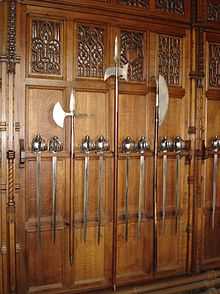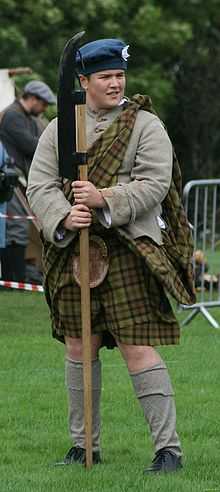Lochaber axe


The Lochaber axe is a type of halberd. The weapon was employed by the Scottish highlanders. The axe itself is similar to tools used with crops, such as the scythe, which is designed for reaping. The hook on the back bears a passing resemblance to a shepherd's crook, although within agriculture a smaller hook such as this may have been used in order to lift and carry tied bundles of a harvested crop or pull down tree branches. Early Lochaber axes, like the billhook, served a dual purpose as both building instruments and farming tools.
Specifics of the weapon
The Lochaber axe took many incarnations, although all of them had a few elements in common. It was a heavy weapon, used by infantry for a defence against cavalry and as a pike against infantry. Like most other polearms of the time, it consisted of two parts: shaft and blade. The shaft was usually some five or six feet (1.5 or 1.8 m) long, and mounted with a blade of about 18 inches (45 cm) in length which usually resembled a bardiche or voulge in design. The blade might be attached in two places and often had a sharp point coming off the top. In addition a hook (or cleek) was attached to the back of the blade. A butt spike was included as a counterweight to the heavy axe head. Langets were incorporated down each side of the shaft to prevent the head from being cut off.
Another idea is that the Lochaber is just the Scottish name for the weapon known as a bardiche; these also occasionally had a backspike or hook too.
Use
In hand-to-hand combat, the axe, in common with other polearms such as the halberd, has a spike on the end, to be used on close combat in a thrusting motion. The axe on the side, coupled with the long pole, delivered a powerful blow to infantry or dismounted cavalry.
Finally, the hook on the back allowed infantry to hook the cavalry off their horses. To accomplish this, as the cavalry charged, the highlanders would suddenly change formation from a large body into smaller bodies of men with clear channels between them. The horses would naturally go into these channels, and the foot soldiers would hook the cavalry off their horses, then use their axes on them with devastating effect. The hook supposedly could also be used for scaling walls.
In history
In about 1570, during the Battle of Bun Garbhain between Clan Cameron and Clan Mackintosh, the Lochaber axe was used by the Camerons. Donald 'Black Taylor of the Axe', son of the 14th chief of Clan Cameron, became notable for his fighting prowess with the axe and became a hero for felling the chief of Clan Mackintosh with it.[1]
Before the Jacobite Rising of 1745 or, simply, "the '45," Lochaber axes were relegated to the Scottish constabulary, and were somewhat viewed as the police baton of the day. In 1745, Prince Charles Stewart raised an army of Scots to oust the Hanoverian King George from the Throne of England and place his father, James VIII of Scotland, on the throne. Many of the Prince's army equipped themselves with Lochaber axes, until such a time they could discard the axes for captured muskets and bayonets or arms supplied by the French.
By around 1767, the Lochaber axe was used mainly as a ceremonial weapon by the town guard of Edinburgh, Scotland.
References
- ↑ "The Battle of BUN GARBHAIN". clan-cameron.org. Retrieved 2008-02-02.